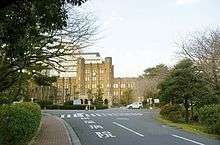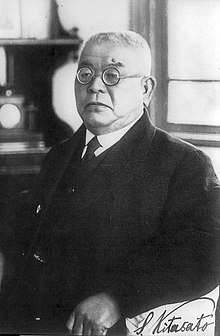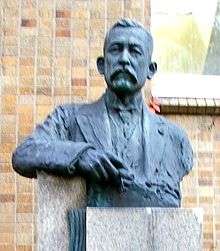Institute of Medical Science (Japan)
The Institute of Medical Science (Tokyo-daigaku Ikagaku Kenkyujyo 東京大学医科学研究所) is an ancillary establishment of Tokyo University. It succeeded the Institute of Infectious Diseases (伝染病研究所, Densen-byo Kenkyu-jo) established in 1892 and is the foremost institute for medical and bioscience research in Japan.

First Building
A research hospital is attached to the institute. The former Institute of Public Health was located on the site.
History
- 1892: Dainihon Shiritu Eiseikai Fuzoku Densenbyo Kenkyujyo (Empire of Japan Private Sanitation Meeting Attachment Institute of Infectious Diseases) was established.
- 1899: It became the National Institute of Infectious Diseases under the jurisdiction of the Ministry of the Interior.
- 1914: The institute entered under the management of the Ministry of Education).
- 1916: It becomes an ancillary establishment of Tokyo Imperial University.
- 1967: Densenbyo Kenkyujyo (Institute of Infectious Diseases) was reorganized, then, Ikagaku Kenkyu-jyo (Institute of Medical Science) was established.
Organization
- Department of Microbiology and Immunology
- Department of Cancer Biology
- Department of Basic Medical Sciences
- Donation Laboratories
- Human Genome Center
- Center for Experimental Medicine
- The Advanced Clinical Research Center
- International Research Center for Infectious
Research facilities
First Building
- Photographic Laboratory (Prof. Jun-ichiro Inoue)
- Research Hospital
- Administration Office Project Accounting Office
- Division of Molecular of Therapy (Prof. Arinobu Tojo)
- Division of Medical Data Processing Network System (Prof. Tetsuo Shimizu)
- Executive Project Coordination Office
- Department of Advanced Medical Science (Prof. Naohide Yamashita)
- Division of Infectious Diseases (Prof. Aikichi Iwamoto)
- Division of Biochemistry (Associate Prof. Seiichi Takasaki)
- Library
- Director's Office (Prof. Naohide Yamashita)
- Dean's Office (Prof. Motoharu Seiki)
- Division of Bioengineering (Prof. Hideaki Tahara)
- Division of Cellular Therapy (Associate Prof. Kohichiro Tsuji)
- Division of Cellular Therapy (Prof. Toshio Kitamura)
- Research Hospital
Second Building
- Laboratory of Social Genome Sciences (Prof. Ichizo Kobayashi)
- Division of Fine Morphology (Prof. Eisaku Katayama)
Third Building
- Laboratory of Molecular Genetics (Prof. Izumu Saito)
- Division of Oncology (Prof. Tadashi Yamamoto)
- Laboratory of Functional Genomics (Prof. Sumio Sugano)
- Division of Neuronal Network (Prof. Toshiya Manabe)
- Department of Infectious Disease Control (Division of Microbial Infection) (Prof. Tetsuro Matano)
- Department of Infectious Disease Control (Division of Viral Infection) (Associate Prof. Yasushi Kawaguchi)
- Department of Infectious Disease Control (Division of Bacterial Infection) (Associate Prof. Ichiro Nakagawa)
- B Common Laboratory (Prof. Chieko Kai)
- Culture Media Section (Prof. Jun-ichiro Inoue)
Fourth Building
- Division of Molecular Pathology (Prof. Yoshinori Murakami)
- Division of Clinical Immunology (Prof. Chikao Morimoto)
- Laboratory of Cell Biology (Prof. Yoichiro Iwakura)
- Division of Host-Parasite Interaction (Prof. Hideo Iba)
- Division of Infectious Genetics (Prof. Kensuke Miyake)
- Radioisotope laboratories (Prof. IWAKURA Yoichiro Iwakura)
- Radioisotope laboratories
Clinical Research Building A
- Division of Cell Processing (CERES) ((Visiting) Prof. Tsuneo Takahashi)
- Cord blood bank
Clinical Research Building B
- Div. Hematopoietic Factors Chugai[1] (Head: Toshio Kitamura)
Research Building (annex)
Open Laboratory Building
- Division of Molecular and Developmental Biology (Oriental・Tomy・Softbank) (Prof.(Visiting) Sumiko Watanabe)
- Division of Stem Cell Engineering (Tooth Regeneration) (Prof. (Visiting) Minoru Ueda)
- Division of Exploratory Research (Ain Pharmaciez) (Associate Prof. (Visiting) Masahiro Kami)
The Core Facility for Therapeutic Vectors
The Scintiscanner room
General Research Building
- Laboratory of DNA Information Analysis (Prof. Satoru Miyano)
- Laboratory of Molecular Medicine (Prof. Yusuke Nakamura)
- Laboratory of Functional Analysis in silico (Prof. Kenta Nakai)
- Laboratory of Genome Technology (Associate Prof. Toyomasa Katagiri)
- Division of Cancer Cell Research (Prof. Motoharu Seiki)
- Division of Molecular Biology (Prof. Yoshikazu Nakamura)
- Division of Mucosal Immunology (Prof. Hiroshi Kiyono)
- Division of Molecular Cell Signaling (Prof. Haruo Saito)
- Division of Bacterial Infection (Prof. Chihiro Sasakawa)
- Division of Virology (Prof. Yoshihiro Kawaoka )
- Pathogenic Microbes Repository Unit (Prof. Chihiro Sasakawa)
- Laboratory Animal Research Center (Prof. Chieko Kai)
- Laboratory of Stem Cell Therapy (Prof. Hiromitsu Nakauchi)
- Division of Cellular and Molecular Biology (Prof. Jun-ichiro Inoue)
- Laboratory of Gene Expression and Regulation (Prof. Nobuaki Yoshida)
Human Genome Center
- Laboratory of Genome Database (Prof. Minoru Kanehisa)
- Laboratory of Sequence Analysis
- Department of Public Policy (Associate Prof. Kaori Mutou)
- Laboratory of Functional Genomics (Prof. Mark Lathrop, Associate Prof. Masao Nagasaki)
- RIKEN SNP Research Center
- Radioisotope Control Room Super Computer Room
- Radioisotope laboratories (Human Genome Center) (Prof. Yusuke Nakamura)
- Radioisotope Laboratory
Human Genome Center (annex)
- Animal Center
- It's gross area is 3.800㎡
- Second Building
 Second Building
Second Building Third Building
Third Building Animal Center
Animal Center General Research Building
General Research Building Human Genome Center
Human Genome Center International Hall
International Hall
Clinical center
- Hospital Building A (New Hospital Building)
- Hospital Building B (Clinical Center)
- Surgical Center Medical Supply Center
- Cell Processing and Transfusion Dialysis room Applied Genomics
- Laboratory Medicine
- Hospital Building C (MRI Facility)
.jpg) Hospital Building A
Hospital Building A- Hospital Building B (Clinical Center)
 Hospital Building C (MRI Facility)
Hospital Building C (MRI Facility) General Research Building and Hospital Building A
General Research Building and Hospital Building A
Ajunct facilities
- Amgen Hall
- This structure was donated from Amgen[2] to the Institute of Medical Science to support medical science research. It contains a main conference room, a smaller conference room, and a laboratory for Tumor Cell Biology (Prof. Toshiki Watanabe)
- Crest Hall
- International Hall
- Shirokane Hall
- In 1999, the house for the co-op (生協, Sheikyō) was remade into Shirokane Hall.
- Medical Science Museum
 The main entrance
The main entrance Entrance which faced "Plachina dori".
Entrance which faced "Plachina dori". North gate
North gate
(usually shut.)
 Kindergarten for children of staff member
Kindergarten for children of staff member Shrine (御宮, Omiya)
Shrine (御宮, Omiya)
 Medical Science Museum
Medical Science Museum Exhibit in the Medical Science Museum
Exhibit in the Medical Science Museum
gollark: What I don't like is when people go from "hmm yes I dislike this" to "this person clearly must be prevented from sharing opinions anywhere".
gollark: See, that's unreasonable, getting angry at people is fine.
gollark: I will probably, to some amount of personal cost, defend people's right to say things I dislike, but that doesn't mean I have to agree with them or particularly support said things.
gollark: You are not going to make people budge on their opinions by saying "no, this opinion is illegal now" or something.
gollark: Okay, too bad, don't let them do much based on it I guess.
See also
- Constructions of the University of Tokyo
- National Institute of Public Health of Japan[3]
Inner links
Campuses of other Global 30 in Japan
- Campus of the University of Tokyo
- Campus of Keio University
- Campus of Kyushu University
External links
![]()
References
- "Chugai Pharmaceutical Co., Ltd". Chugai-pharm.co.jp. Retrieved 2013-02-18.
- "amge.com". Amgen.com. Retrieved 2013-02-18.
- "Campus Map | The Institute of Medical Science, The University Of Tokyo". Ims.u-tokyo.ac.jp. Retrieved 2013-02-18.
This article is issued from Wikipedia. The text is licensed under Creative Commons - Attribution - Sharealike. Additional terms may apply for the media files.

